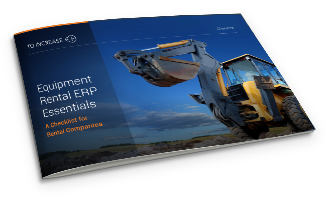6 Ways Equipment Rental Software Prevents Revenue Loss
 Michiel Toppers
Michiel Toppers
Table of contents
One concern that haunts every equipment rental business is to improve the bottom line. While the overall market and forecasts seem encouraging for the equipment rental industry, companies must focus on maximizing revenue flow to stay competitive.
However, when dealing with vast operations that may span different countries, it is easy to lose equipment, miss invoices, or not account for specific revenue — which is detrimental to your business.
As a company in the rental business, you must make the most of your fleet. You must wonder, "I have not incurred any losses, so am I really losing revenue?" Well, your overall revenue can bleed in more than one way.
With an experience of nearly two decades in the equipment rental industry, we have observed rental companies failing to realize the revenue they could have gained with the appropriate technology in place.
This blog will share some common ways equipment rental companies lose revenue and how to quickly mitigate the risk of revenue loss with equipment rental software.
6 common ways equipment rental companies lose revenue
1. Unavailability of rental equipment
One factor that affects the flow of revenue in the equipment rental business is the unavailability of rental assets. This unavailability could be due to asset repair, equipment maintenance, or complete booking.
Being unable to fulfill customer demands due to equipment unavailability leads your customers to turn to competition, which impacts your business in the long run.
How equipment rental software helps
Equipment rental ERP software allows you to manage the lifecycle of an asset right from the purchase to the end-of-life stage. This feature helps you maximize the equipment's utilization and availability.
With data on equipment availability and location, you can schedule and monitor your rental assets across rental contracts or projects that span multiple months. This data increases scheduling accuracy, minimizes service gaps, and reduces overhead costs.
Here's how equipment rental software can support the various lifecycle stages of the rental equipment:
2. Inefficient equipment delivery and transportation
Another major roadblock to improving the rental equipment revenue is the time it takes to pick up the asset from one customer and deliver it to the next customer on time. It is imperative to schedule an asset without overlap, leave enough time for post-rental maintenance, and avoid unnecessary downtime.
Late pickups can lead to delayed deliveries, resulting in disgruntled customers and causing revenue loss and reputational damage. Additionally, if you do not focus on the shortest route possible for delivering the rental equipment, you lose more time and money on the transportation of the equipment.
How equipment rental software helps
An equipment rental software solution can help you with transport planning and management to streamline logistics and ensure timely deliveries to customers. You can use the graphical plan board that will show you each asset's exact location and usage.
With a complete overview of the operators, the asset location, and the movement schedule, you can avoid overscheduling, missing out on maintenance, or a long idle time. Additionally, investing in a mobile app that shows the shortest and most efficient transport routes to take for better cost control could be beneficial.
3. Unable to capitalize on packages
Any chance to lose potential revenue is also considered a 'revenue loss.' In many equipment rental projects, customers require bundle packages. However, without the correct information, you may be unable to provide all the necessary services, making you miss potential revenue gains.
For instance, you can offer a tipper to a customer renting an excavator as both pieces of equipment are often used in tandem. With a lack of insights into the right assets to pair through upselling or cross-selling, you miss out on a significant portion of your profits.
How equipment rental software helps
Equipment rental ERP software allows you to build rental kits or bundle packages. These kits or packages of equipment are often rented together and can work with each other.
Some rental software solutions leverage artificial intelligence to recommend 'frequently rented or bought products' for your customers to increase cross-sell and upsell opportunities.
You can rent serialized and non-serialized equipment to your customers as a package for their projects. This also makes it easier for your customers as they can rent out all the required equipment from one place at competitive prices.
4. Inability to monitor utilization
When renting out equipment to customers, the equipment must be used according to the rental contract and conditions. For instance, some sensitive electric materials cannot be used continuously due to heating or other damage, limiting the use to a specific number of hours.
However, in most cases, there are no means of tracking the usage, as the customer's site would be remotely located. Overusing your equipment (as opposed to the agreed terms) represents missed revenue and an additional strain on the rented equipment.
How equipment rental software helps
With technology like the Internet of Things (IoT), equipment rental software can help you precisely track and monitor the movement and usage of your assets. Tracking the activity of the assets ensures your customers adhere to their rental contracts' terms.
In the case of overutilization, you can bill the customer for the extra usage, enabling precise invoicing. Additionally, tracking equipment usage helps you keep equipment in reasonable condition by proactively planning the required service and maintenance.
5. Lack of insights
In the rental industry, the equipment in demand keeps changing due to many macro factors. For instance, the increase in infrastructure projects created a higher demand for construction equipment, and the COVID-19 pandemic led to a rise in medical equipment.
Based on the industry you specialize in, if you are not up to date with your best-performing versus your least-performing assets, you could miss making the right investment decisions, losing money year after year.
How equipment rental software helps
Equipment rental software that supports analytics and business intelligence can offer you an overview of the assets in high demand and with the highest rates. Having this information will help you plan better and make informed investment decisions.
You can draw insights on asset performance and utilization based on measured KPIs and adjust the rental rates to maximize your revenue. Using advanced analytics with graphical dashboards, you can accurately forecast equipment demand and enhance your financial planning.
6. Missed or delayed communication
The equipment rental operation has multiple touch points, each handled by a different team - back office, warehouse, field service, operations, or administration. With many teams responsible for a single piece of equipment, even a tiny communication gap could put you in an unfavorable position.
For instance, if the field teams do not readily update changes requested by the customer to the back office, it could lead to dissatisfied customers. There could be changes in the rental agreement, a request for a different size of equipment, or an extension of the rental period - all of which are critical pieces of data that significantly impact overall operations.
How equipment rental software helps
Equipment rental software that can manage all the rental, financial, sales, logistics, and service processes in one system simplifies the exchange of information among different departments.
As mentioned earlier, equipment rental software today allows various teams involved in the rental operation to access data in real-time on mobile devices of their choice. You can also connect your rental ERP to a CRM system to handle the entire lead-to-cash rental process in one location.
Want to streamline your operations with equipment rental software?
The right equipment rental software can make or break your business. Look for technology and solution providers that fit your long-term growth strategy.
Here are some steps to select the right equipment rental software:
- Evaluate the problem areas in your business that affect revenue generation.
- Discuss the possible solutions to resolve these issues with different teams.
- Calculate the costs (actual and opportunity) of equipment rental ERP software.
-
Discuss the business case, ROI, and operational impact with stakeholders.
Begin your journey on what to look for in a rental software solution by clicking the checklist below.
This checklist shares the Equipment Rental ERP Essentials, so you know:
- The selection criteria to consider
- The crucial rental ERP essentials
- The conditions to ensure the success of your software
Alternatively, if you want an end-to-end, cloud-based solution, you could explore our rental software, STAEDEAN Rental Management, embedded in Dynamics 365 Finance and Supply Chain Management.


